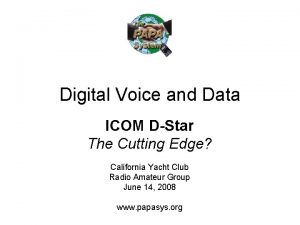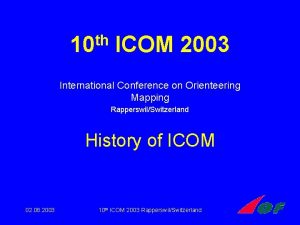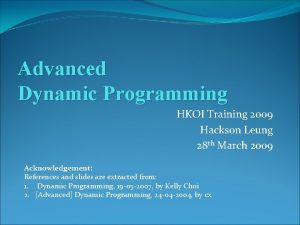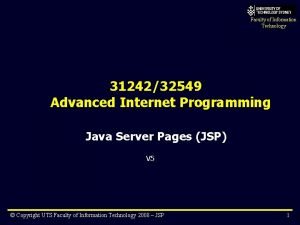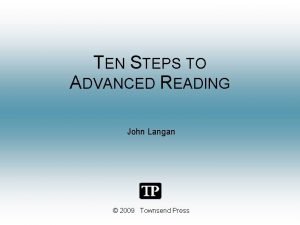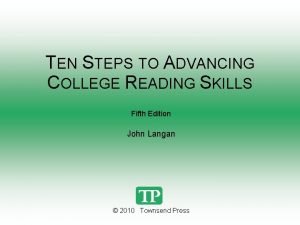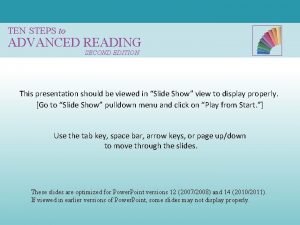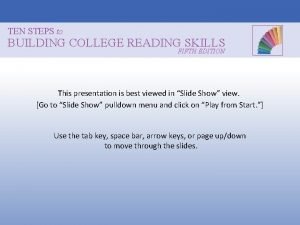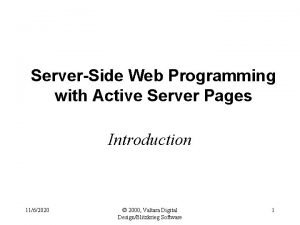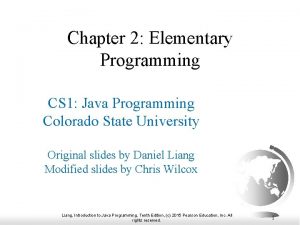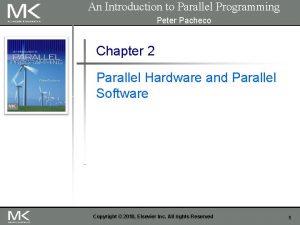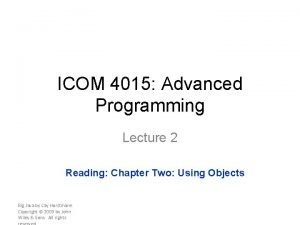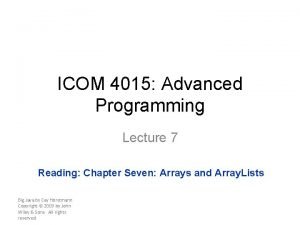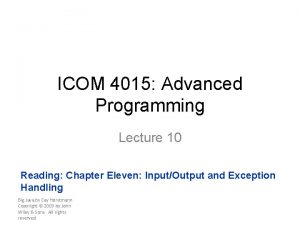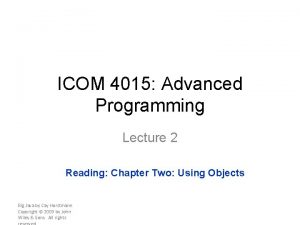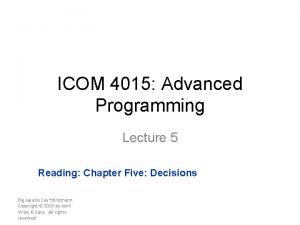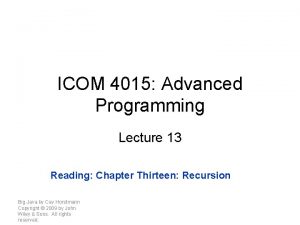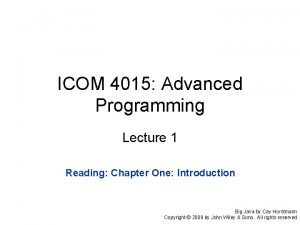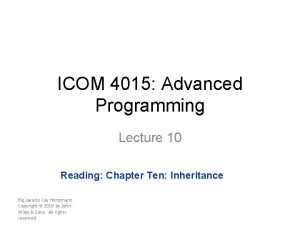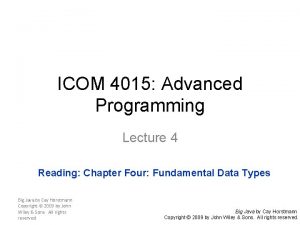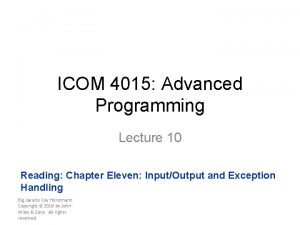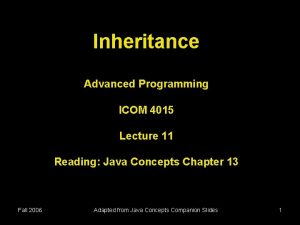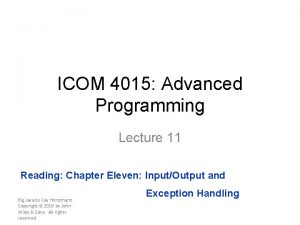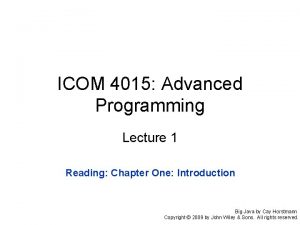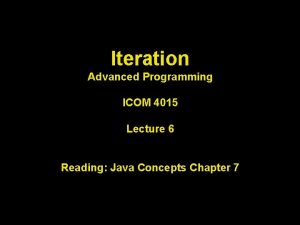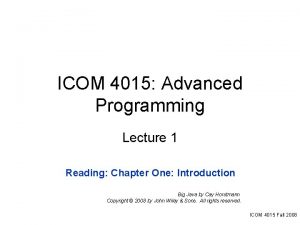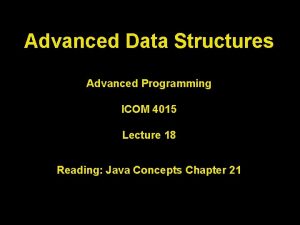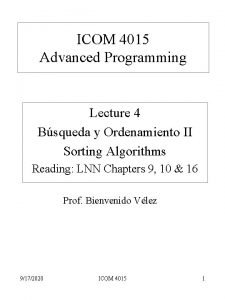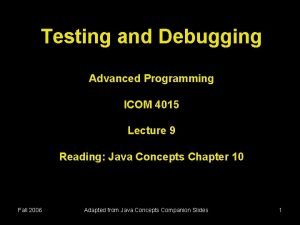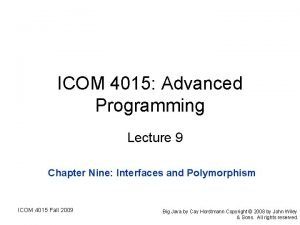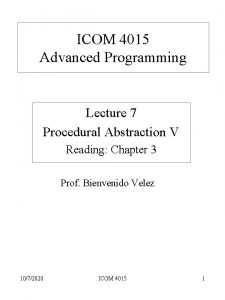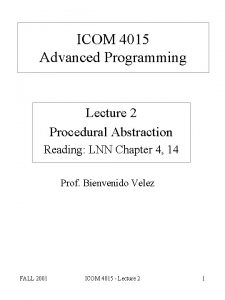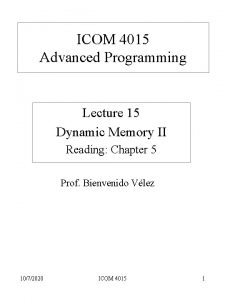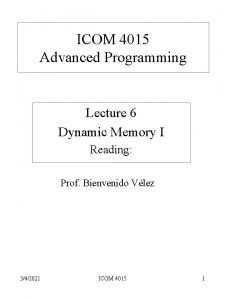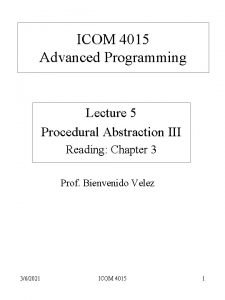Introduction Advanced Programming ICOM 4015 Lecture 1 Reading




















![A Simple Program • • public class Class. Name public static void main(String[] args) A Simple Program • • public class Class. Name public static void main(String[] args)](https://slidetodoc.com/presentation_image_h2/b9c3018f0d84a6d071426455a365d235/image-21.jpg)


















- Slides: 39

Introduction Advanced Programming ICOM 4015 Lecture 1 Reading: Java Concepts Chapter 1 Fall 2008 Slides adapted from Java Concepts companion slides 1

Lecture Goals • To understand the activity of programming • To learn about machine code and high level programming languages • To become familiar with your computing environment and your compiler • To compile and run your first Java program • To recognize syntax and logic errors Fall 2008 Slides adapted from Java Concepts companion slides 2

What Is Programming? • Computers are programmed to perform tasks • Different tasks = different programs • Program Sequence of basic operations executed in succession Contains instruction sequences for all tasks it can execute • Sophisticated programs require teams of highly skilled programmers and other professionals Fall 2008 Slides adapted from Java Concepts companion slides 3

What are Computers Good for? • Can store large amount of data Instructions to be executed (programs) Data to operate with • Can execute very simple instructions from a predetermined set of possible instructions Access particular data in memory (read) Store data in memory (write) Operate with data in CPU • Perform logical/arithmetic operations Make data available to an external source Get data from an external source • Executes instructions fast – millions per second… • Instructions must be provided in native language (machine language) Fall 2008 Slides adapted from Java Concepts companion slides 4

Machine Instructions • Need to be coded following a very specific format (machine language) Very detailed Each instruction performs a simple task • General categories of machine instructions: Control instructions – tell the computer what to do next Data handling instructions – operate on data stored, or to be stored, in the computer’s memory • • • Fall 2008 Alter data Compute new data Write data to memory Read data from memory Write data to an external device (output) Read data from an external device (input) Slides adapted from Java Concepts companion slides 5

Instruction Execution • Instruction is read from memory • Instruction is placed in special register in CPU • Signals are initiated to activate required computer components to perform a particular task These correspond to the purpose of the instruction • Instructions are execute sequentially (except in parallel architectures) Only one instruction at a time When an instruction is finished, the next instruction in the sequence is executed • Except in the case of control instructions that may alter the sequence of instructions to execute. Fall 2008 Slides adapted from Java Concepts companion slides 6

Machine Code • Java Virtual Machine (JVM) – a typical sequence of machine instructions is: 1. Load the contents of memory location 40. 2. Load the value 100. 3. If the first value is greater than the second value, continue with the instruction that is stored in memory location 240. Machine instructions are encoded as numbers: 21 40 Fall 2008 16 100 240 Slides 163 adapted from Java Concepts companion slides Continued… 7

Machine Code • Compiler translates high-level language to machine code Fall 2008 Slides adapted from Java Concepts companion slides 8

Self Check 1. What is the code for the Java virtual machine instruction "Load the contents of memory location 100"? 2. Does a person who uses a computer for office work ever run a compiler? Fall 2008 Slides adapted from Java Concepts companion slides 9

Answers 1. 21 100 2. No–a compiler is intended for programmers, to translate high-level programming instructions into machine code. Fall 2008 Slides adapted from Java Concepts companion slides 10

Programming Languages • Machine/Virtual Machine 21 40 16 100 163 240 • Assembler iload int. Rate bipush 100 if_icmpgt int. Error • High-level language if (int. Rate > 100). . . Fall 2008 Slides adapted from Java Concepts companion slides 11

Common Approach with High-Level Language Programs Program P in language L Compiling process Compiler program for L (in M 1) produces (if no grammar errors) Machine Code Fall 2008 same Program P in language L Compiler program for L (in M 2) produces Program P in machine language of M 1 Program P in machine language of M 2 Machine M 1 Machine M 2 Slides adapted from Java Concepts companion slides machine dependable 12

Approach Followed by Java System Program P in language Java Compiling process (if no grammar errors) Machine Code Fall 2008 same Program P in language Java Compiler program for Java (in M 1) Compiler program for Java (in M 2) produces Program P in machine language of JVM same Program P in machine language of JVM in M 1 JVM in M 2 Machine M 1 Machine M 2 Slides adapted from Java Concepts companion slides Machine dependable Can be executed in any JVM Machine dependable 13

The Java Programming Language • Simple • Safe • Platform-independent ("write once, run anywhere") • Rich library (packages) • Designed for the internet Fall 2008 Slides adapted from Java Concepts companion slides 14

Applets on a Web Page Figure 7: Applets on a Web Page Fall 2008 Slides adapted from Java Concepts companion slides 15

Self Check 1. What are the two most important benefits of the Java language? 2. How long does it take to learn the entire Java library? Fall 2008 Slides adapted from Java Concepts companion slides 16

Answers 1. Safety and portability. 2. No one person can learn the entire library–it is too large. Fall 2008 Slides adapted from Java Concepts companion slides 17

File Hello. Tester. java 1: public class Hello. Tester 2: { 3: public static void main(String[] args) 4: { 5: // Display a greeting in the console window 6: 7: System. out. println("Hello, World!"); 8: } 9: } Output Hello, World! Fall 2008 Slides adapted from Java Concepts companion slides 18

Hello. Tester in a Console Window Figure 11: Running the Hello. Tester Program in a Console Window Fall 2008 Slides adapted from Java Concepts companion slides 19

Hello. Tester in an IDE Figure 12: Running the Hello. Tester Program in an Integrated Development Environment Fall 2008 Slides adapted from Java Concepts companion slides 20
![A Simple Program public class Class Name public static void mainString args A Simple Program • • public class Class. Name public static void main(String[] args)](https://slidetodoc.com/presentation_image_h2/b9c3018f0d84a6d071426455a365d235/image-21.jpg)
A Simple Program • • public class Class. Name public static void main(String[] args) // comment Method call Figure 13: Calling a Method System Class System. out Object println Fall 2008 Method Slides adapted from Java Concepts companion slides 21

Syntax 1. 1: Method Call object. method. Name(parameters) Example: System. out. println("Hello, Dave!"); Purpose: To invoke a method of an object and supply any additional parameters Fall 2008 Slides adapted from Java Concepts companion slides 22

Self Check 1. How would you modify the Hello. Tester program to print the words "Hello, " and "World!" on two lines? 2. Would the program continue to work if you omitted the line starting with //? 3. What does the following set of statements print? System. out. print("My lucky number is"); System. out. println(3 + 4 + 5); Fall 2008 Slides adapted from Java Concepts companion slides 23

Answers 1. System. out. println("Hello, "); System. out. println("World"); 2. Yes–the line starting with // is a comment, intended for human readers. The compiler ignores comments. 3. The printout is My lucky number is 12. It would be a good idea to add a space after the is. Fall 2008 Slides adapted from Java Concepts companion slides 24

Different Types of Errors • Syntax errors System. ouch. print(". . . "); System. out. print("Hello); Detected by the compiler • Logic errors System. out. print("Hell"); Detected (hopefully) through testing @ RUNTIME Fall 2008 Slides adapted from Java Concepts companion slides 25

Self Check 1. Suppose you omit the // characters from the Hello. Tester. java program but not the remainder of the comment. Will you get a compile-time error or a run-time error? 2. How can you find logic errors in a program? Fall 2008 Slides adapted from Java Concepts companion slides 26

Answers 1. A compile-time error. The compiler will not know what to do with the word display. 2. You need to run the program and observe its behavior. Fall 2008 Slides adapted from Java Concepts companion slides 27

The Compilation Process Figure 14: From Source Code to Running Program Fall 2008 Slides adapted from Java Concepts companion slides 28

The Edit—Compile—Loop Test Figure 15: The Edit—Compile—Loop Test Fall 2008 Slides adapted from Java Concepts companion slides 29

Self Check 1. What do you expect to see when you load a class file into your text editor? 2. Why can't you test a program for run-time errors when it has compiler errors? Fall 2008 Slides adapted from Java Concepts companion slides 30

Answers 1. A sequence of random characters, some funny-looking. Class files contain virtual machine instructions that are encoded as binary numbers. 2. When a program has compiler errors, no class file is produced, and there is nothing to run. Fall 2008 Slides adapted from Java Concepts companion slides 31

END OF LECTURE 1 Fall 2008 Slides adapted from Java Concepts companion slides 32

Becoming Familiar with your Computer • Log in • Locate the Java compiler • Understand files and folders Programs are kept in files File: a collection of items of information that are kept together Files have names, and the rules for legal names differ from one system to another Files are stored in folders or directories; these file containers can be nested Fall 2008 Slides adapted from Java Concepts companion slides 33 Continued…

Becoming Familiar with your Computer • Write a simple program (later) • Save your work Develop a strategy for keeping backup copies of your work Fall 2008 Slides adapted from Java Concepts companion slides 34

A Shell Window Figure 8: A Shell Window Fall 2008 Slides adapted from Java Concepts companion slides 35

An Integrated Development Environment Figure 9: Fall. Integrated 2008 Slides adapted from Java Concepts companion slides An Development Environment 36

Nested Folders Fall 2008 Figure 10: Folders Slides. Nested adapted from Java Concepts companion slides 37

Self Check 1. How are programming projects stored on a computer? 2. What do you do to protect yourself from data loss when you work on programming projects? Fall 2008 Slides adapted from Java Concepts companion slides 38

Answers 1. Programs are stored in files, and files are stored in folders or directories. 2. You back up your files and folders. Fall 2008 Slides adapted from Java Concepts companion slides 39
 Icom ic-2730a vs kenwood tm-v71a
Icom ic-2730a vs kenwood tm-v71a Papasys
Papasys Icom
Icom Icom model project management
Icom model project management Maksud bayaran balik emolumen tl n tax 4020
Maksud bayaran balik emolumen tl n tax 4020 Pre reading while reading and post reading activities
Pre reading while reading and post reading activities 01:640:244 lecture notes - lecture 15: plat, idah, farad
01:640:244 lecture notes - lecture 15: plat, idah, farad Advanced inorganic chemistry lecture notes
Advanced inorganic chemistry lecture notes C programming lecture
C programming lecture Advanced dynamic programming
Advanced dynamic programming Advanced internet programming
Advanced internet programming Imperative statement in system programming
Imperative statement in system programming Language processor
Language processor Advanced programming in java
Advanced programming in java Ten steps to advanced reading answer key
Ten steps to advanced reading answer key Ten steps to advanced reading 2nd edition answers
Ten steps to advanced reading 2nd edition answers Ten steps to advanced reading
Ten steps to advanced reading Ten steps to advancing college reading skills
Ten steps to advancing college reading skills Perbedaan linear programming dan integer programming
Perbedaan linear programming dan integer programming Greedy vs dynamic
Greedy vs dynamic Runtime programming
Runtime programming Integer programming vs linear programming
Integer programming vs linear programming Definisi integer
Definisi integer Introduction to biochemistry lecture notes
Introduction to biochemistry lecture notes Introduction to psychology lecture
Introduction to psychology lecture Introduction to algorithms lecture notes
Introduction to algorithms lecture notes Advanced higher english dissertation examples
Advanced higher english dissertation examples Round robin reading vs popcorn reading
Round robin reading vs popcorn reading Aims of teaching
Aims of teaching While reading stage
While reading stage What is shared reading
What is shared reading It involves scrutinizing
It involves scrutinizing What is extensive reading
What is extensive reading Extensive reading
Extensive reading Reading techniques and strategies
Reading techniques and strategies Introduction to server side programming
Introduction to server side programming Problem solving
Problem solving Introduction to programming languages
Introduction to programming languages Elementary programming in java
Elementary programming in java An introduction to parallel programming peter pacheco
An introduction to parallel programming peter pacheco

